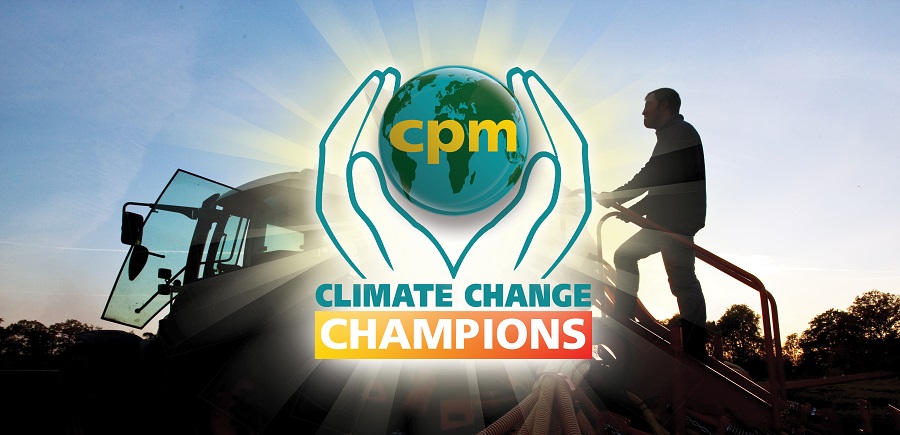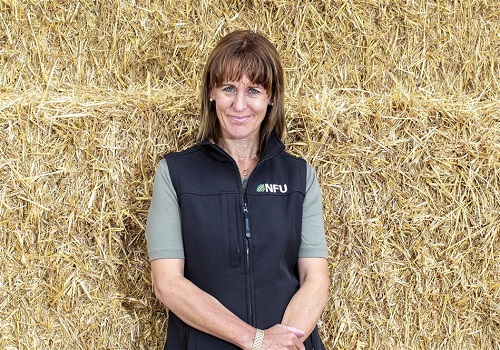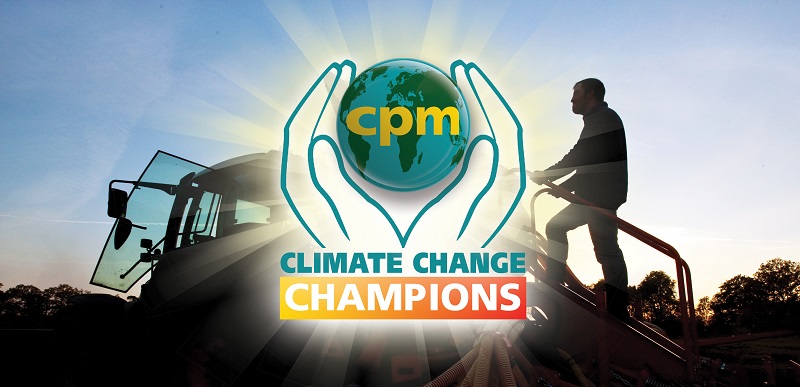
The arable sector’s 2020 Climate Change Champions presented the progress and problems on their journey to Net Zero at a round table event, hosted by NFU and attended by Defra minister Victoria Prentis. CPM summarises the discussion.
Big corporate companies should be working with us to offset carbon, pushed by a government that sees farmers as the solution, not the problem.
By Tom Allen-Stevens
Now is the time for UK arable farmers to step forward with potential solutions for climate change.
The sector is uniquely placed to deliver the practices required to help farming meet its ambitious target of Net Zero emissions by 2040, according to attendees of a high-level round-table event, organised by CPM and hosted by NFU. A collaborative approach is key to success, involving the whole supply chain and led by those in the arable sector with a mindset for positive change. Farmers and industry have also called on Government for clear policy objectives, a united method of monitoring and measuring greenhouse gas (GHG) emissions, and an approach to regulation that favours the circular economy.
“This is our time,” declared NFU president Minette Batters who attended and introduced the event. “But it is only our time if we make it our time. We now have to work together to make it happen.”

Minette Batters believes there’s an opportunity for the UK to lead on climate change, but it requires mindset change at scale
The Agriculture Act presents a “landmark moment” that will set the path for a new future, she said. With 85% of people wanting to see growers producing more food here, and with the UK hosting the COP26 United Nations climate change discussions in 2021, Minette believes there’s a “global opportunity” for thought-leaders in UK farming to be part of the solution.
“This is such an opportunity for the UK to lead, but it does mean mindset change at scale and not just across the farming community – it’s got to go across consumers too.”
Also attending the event was Defra farming minister Victoria Prentis. She said the NFU target of Net Zero by 2040 is “ambitious, but as these farmers here today have demonstrated, it is possible. It’s really, really great to see leaders in climate change within the agricultural world.”
The minister was referring to eight Climate Change Champions who were leading the discussion and who stepped forward with their ideas over a year ago, which have been profiled in CPM throughout 2020. In all, the event drew together over 40 key influencers in the arable sector who can drive the ambition for Net Zero.
So how can farmers achieve this goal? “Everything must dovetail together,” said Al Brooks, estate director of Faccombe Estate near Andover, Hants, and the farmer voted by CPM readers as Climate Change Champion 2020.
“We have a desire to build a sustainable community. It’s not just an arable farming approach, but a whole edge-to-edge asset approach. We try to add value wherever we can from both a financial and environmental perspective.”
Hamish Campbell, farming in the Cotswolds, achieves his targets through working with local markets and AD plants, putting back what he takes out – what he calls “just doing the basics”. But he agreed there’s a “massive opportunity” to do more: “Big corporate companies should be working with us to offset carbon, pushed by a government that sees farmers as the solution, not the problem.”
Not every farmer can achieve Net Zero through pushing productivity, noted John Hawkins. He’s put his whole farm in the rolling Dorset countryside near Blandford Forum into mid-tier stewardship which he estimates will “lock in” up to 10,000t of CO₂ over 10 years. “Some farmers will grow food really intensively, while others on the less quality land will probably help offset that,” he suggested.
Net zero isn’t a “singular ambition” for David Miller of Wheatsheaf Farming near Basingstoke, Hants. “It will happen in conjunction with and as a result of a strategic change to our farming system.”
David uses cover, catch and companion crops in conjunction with a zero-tillage approach to establishing crops. Integrated Pest Management is a “cornerstone” of the system that has helped reduce CO₂ emissions by 65% over 10 years. He called it “a responsible way to produce high quality food, while the environment gains by having more biodiversity with a better natural balance”.
Andrew Pitts, farming at Mears Ashby in Northants is convinced UK farmers can build the “resilience and balance” needed to reach carbon neutral well before 2040. He called on the minister to “give us the help we need working together”, spelling out the need to retain glyphosate and to classify “perfectly safe” composted materials as a fertiliser, not a waste product.
“We need to be allowed to use science because science, such as gene-editing, will help us solve many problems,” he added.
Cambs grower Tom Pearson brought with him three examples of his experiences in the journey towards Net Zero. “The first one is a change in mindset. The second is committing to a regenerative agriculture system. The third example is current technology – game-changing ag-tech and farmer groups,” he said.
He uses the Farm Carbon Toolkit to measure progress gained through a steady transition to no-till, maximising green cover and widening rotations. Tom looks forward to the day in the “not-too-distant future” when “herbicide-free robotic weeding” does away with current control measures for blackgrass.
Clive Pullin, near Stowe in Bucks, runs a mixed farm producing “a lot of food” – milk, sheep as well as cereals. “My goal is to be part of this carbon challenge – keep the carbon in the ground and not import it wherever possible,” he noted.
This is achieved through each enterprise feeding the other, with new tractor technology, zero tillage and precision farming used to best effect. “We are able now to put the nutrients where the crops want it, and I’ve managed to reduce my oil-based fertiliser from 550t/yr to 115t/yr.”
Similarly, Charlie Steer of Grosvenor Farms in West Cheshire focuses on the circular economy, milking over 2500 cows and farming 2300ha. Best use of organic manure, food waste, rotational diversity and precision farming underpin production.
“Yield has to remain paramount on our most productive land and in the dairy unit to minimise both carbon and financial cost per unit of output. So our carbon cost per kg of milk produced has reduced from 1.22kg to 0.86kg for 2020, equivalent to a reduction of over 11,000t/yr.” A keen advocate of the 4 per 1000 initiative, whereby every farmer aims to raise soil organic matter by 0.4% per year, Charlie’s seen those at Grosvenor Farms lift by 0.53% in just three years.
He uses the Agrecalc tool, developed by SRUC to monitor this, and raised the need for an internationally recognised standard for carbon budgeting on farms. Minette indicated this was a priority area for NFU but cautioned that experience with reducing antibiotic usage in livestock showed carbon calculators shouldn’t become “competitive”.
“Carbon budgeting has got to be globally recognised,” she said. “The worst thing we can do is to tie our farmers hands with recognition of what is needed and then we import and undermine underneath.”
Emma Ralph of Interagro noted that not all carbon tools run to the same criteria, calling for a more “joined-up”, transparent solution. “It takes a collaborative approach across all industries,” she pointed out.
Al added that “payment by results means tangible results that are measurable, transparent and trusted. Carbon calculators must be on the same page in terms of a level playing field in the results they give. Whatever we do needs to stand up to scrutiny.”
NFU combinable crops board chairman Matt Culley noted that the storage of carbon that’s then released isn’t accounted for in carbon sequestration. This point was picked up by Mike Green of BASF – the food carbon produced isn’t credited as a positive for farming, he said.
“When it leaves the farm, that carbon in the grain or meat or milk is counted as a negative because it doesn’t remain. But if you think about all your inputs that have been put on to grow the crops, they’re sequestering CO₂ all the time.”
Accounting for carbon all the way through the chain would point out the “real low-lying fruits”, such as minimising waste in households, added George Fisher of CF Fertilisers. Different carbon models are a factor of working within an unrestricted market place, he added. “That’s what free markets do, but we must ensure that they all align with the highest standard.”
David pointed out the industry shouldn’t get “bogged down” with understanding the finer detail of its carbon footprint before it’s looked at the “big picture stuff”. “At the moment we’re looking at the big carbon issues – nitrogen-based fertilisers, and on the positive side organic matter,” he said.
The focus of the discussion turned to the carbon footprint of machinery used to carry out field operations. Matt noted that most carbon calculators just look at diesel usage. “Is that acceptable? Or are we going to need things like telematics to give us the actual correct data so it can be audited properly and accurately?” he asked.
Yuri Dantilio of BKT tyres pointed out the contribution these make to carbon costs. “Essentially using the tyres increases efficiency and also makes it last longer. And it also performs better in terms of traction and fuel consumption.” Specialist tyres developed for high road usage help here, while very high flexion technology is designed to reduce compaction and avoid soil damage, he added.
Ben Scott Robinson of Small Robot Company suggested it’s the machines themselves that cause the problem. “Unless we can lighten the load on the field by removing a lot of the weight from the machinery, then we’ll just be applying Band Aids to the problems around having 10s of tonnes of kit creating compaction that we have to resolve in other ways.”
The real problem lies in covering large areas of ground in tricky weather windows, said Martin Hamer of Fendt. “Looking at tyre technology and inflation pressures can spread the load. We see more and more farmers opting for direct drilling, so you don’t need such a big tractor trafficking your fields.”
Sean Groom of Pöttinger added the construction of machinery has a role to play. “There is the use of alternative forms of plastic that can replace some steel materials. There’s also cast aluminium components, particularly when it comes to things like coulter arms that can reduce the overall weight of a product.”
So when it comes to sequestering carbon, how should farmers be paid, and could the private sector help? “The key in this is to get that carbon account, of carbon captured in arable crops on the farm,” said Matt.
“The way forward may be linking up with supply chains and essentially sharing the information on carbon storage right throughout the supply chain.”
While you can buy carbon credits through the internet for around £3/t, Mike noted farmers should be duty bound to reduce their own emissions before seeking to be rewarded for offsetting others. “Perhaps there should be two types of carbon credits – stocks of permanently sequestered carbon and the carbon flow, done on a more field-by-field basis. If someone says they’ve sequestered 5000t of carbon, whoever buys that needs to know it’s still there.”
Matt confirmed that identifying the perfect carbon-accounting system is a key priority for NFU’s Net Zero campaign, while benchmarking will then help farmers take the policy forward. E10 – statutory inclusion of at least 10% of biofuels for all road users – is another key lobbying point, along with ensuring the clean air strategy results in practical outcomes and best use is made of IPM.
“On livestock, new intensive units could be planned within larger arable areas that don’t have much livestock within them at the moment. Greater collaboration between livestock and arable has the potential to reduce our carbon footprint,” concluded Matt.
Step forward to save the planet
Step forward to save the planet
The quest is on to find the Climate Change Champions of 2021 – those arable farmers who have already made palpable progress towards Net Zero. We believe those individuals currently have their eyes set on this very page. All you have to do is step forward and nominate yourself.
Throughout 2021, we’ll be profiling in CPM a shortlist of candidates, selected from those nominees by a judging panel. The campaign is supported by NFU, and supports its goal of achieving Net Zero by 2040. Specifically, we’re looking for arable farmers with:
- Inspirational ideas – more than anything, this is the opportunity for those with innovative practices or novel thinking to come forward and show how these help the journey towards Net Zero.
- Productivity push – those using a wide variety of techniques to enhance productivity and deliver the same output or more, and those working smarter to use fewer inputs.
- Cultivation care – those using measures to build soil organic matter and lock carbon into the land, which may involve cultivation practice, a change in rotation or alternative land use.
- Bio-based boldness – farmers who have implemented measures or activities that positively displace the use of fossil fuel or other causes of greenhouse gas (GHG) emissions elsewhere in society. Examples include anaerobic digesters, solar and wind and alternative uses for agricultural products that lock up carbon.
To find out more, and to nominate yourself for Climate Change Champions 2021, go to www.cpm-magazine.co.uk/climatechangechampions. Nominations close 31 Jan 2021.




